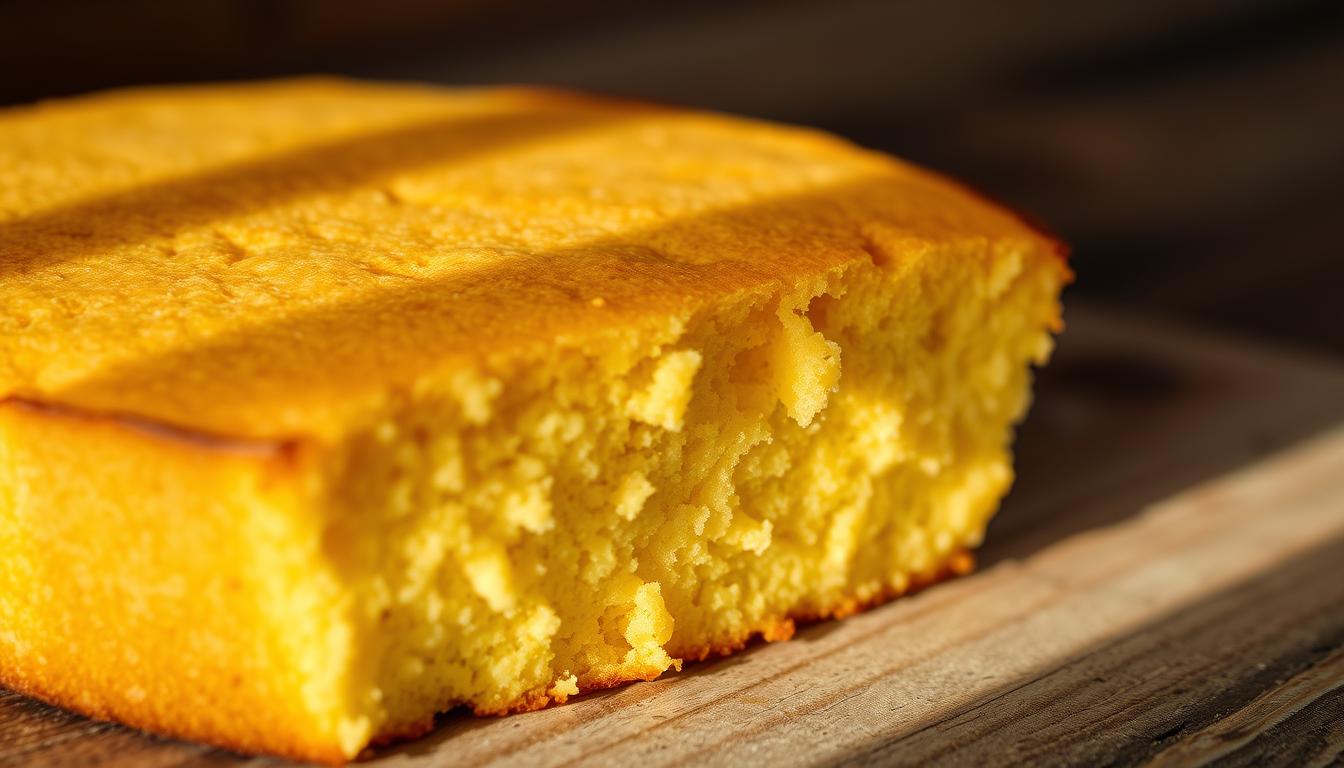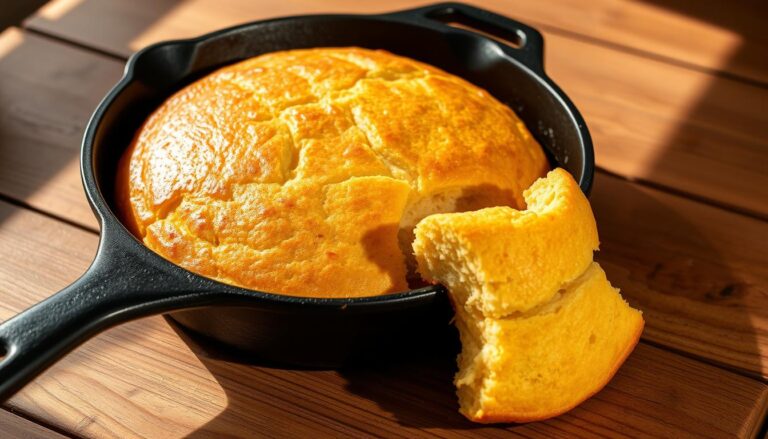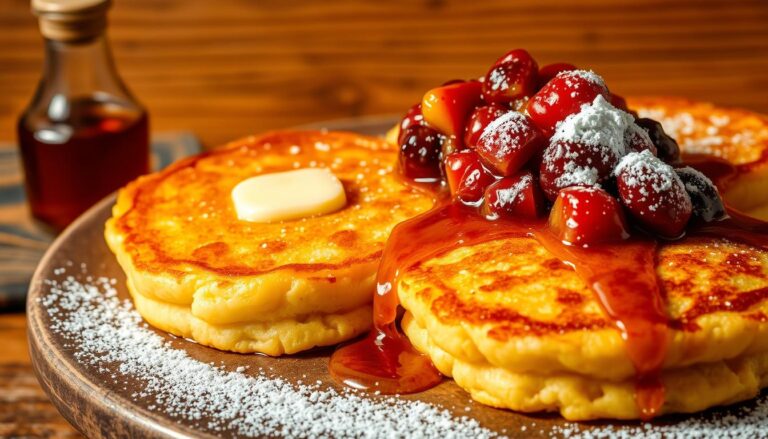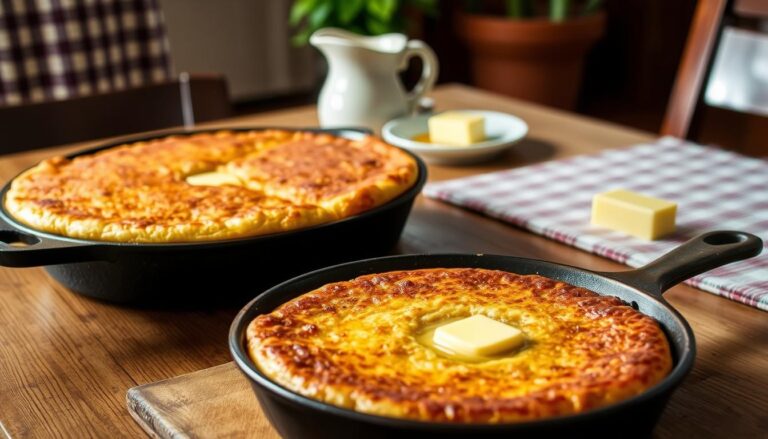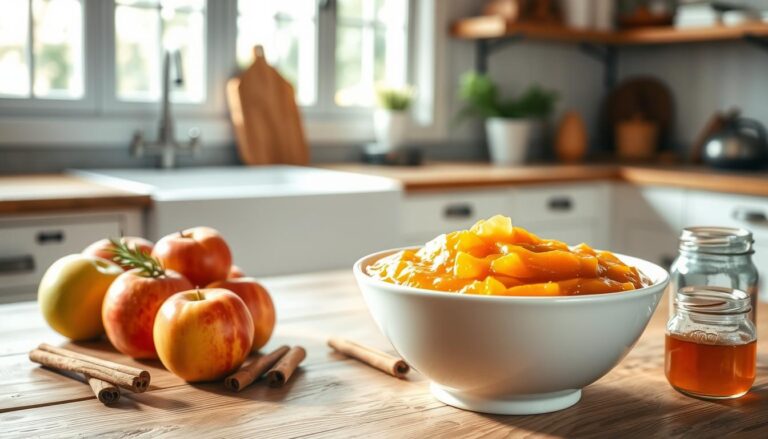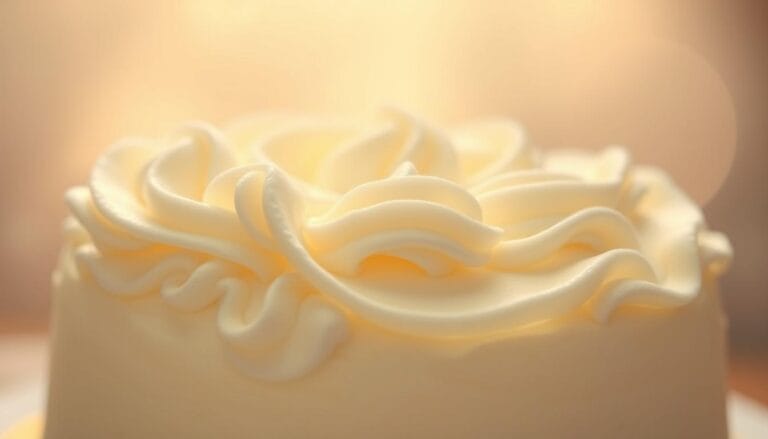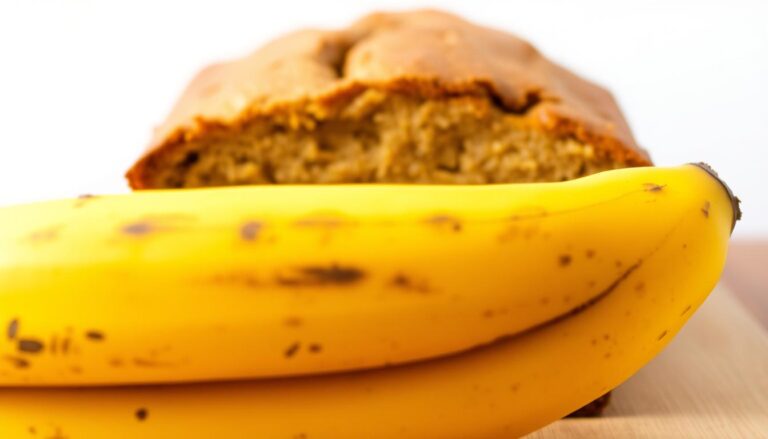Are cornbread hoe cakes and Johnny cakes the same?
Growing up in the South, I remember the warm kitchen aromas. My grandmother’s cornbread hoecake sizzling on a cast-iron skillet was unforgettable. Those golden, crispy edges held memories deeper than just a simple bread—they whispered stories of family traditions and cultural heritage.
When you first encounter hoe cakes and Johnny cakes, you might wonder if they’re identical twins or distant culinary cousins. These corn-based breads share remarkable similarities. They often blur the lines between traditional Southern recipes. Both originate from rich Native American and early American cooking techniques, creating a delicious connection to our culinary roots.
In this exploration, we’ll uncover the nuanced differences between hoe cakes and Johnny cakes. From their ingredients to regional variations, you’ll gain insight into these beloved Southern staples. They have graced family tables for generations. Prepare to dive into a delectable journey through cornbread history. It will transform how you view these humble yet extraordinary breads.
Table of Contents
The Historical Origins of Hoe Cakes and Johnny Cakes
Hoe cake bread is a journey through American history. It’s a story of cultural exchange and survival over centuries. Native Americans first made these corn-based breads, which became a key part of Southern cuisine.
The story of hoe cakes is quite interesting. Early Native American tribes ground corn into a fine meal. They made a basic recipe for hoe cakes that fed many people. European settlers then took these recipes and made them their own.
Native American Influence on Corn-Based Breads
Indigenous cooking traditions were key in making corn-based breads. They used:
- Stone mills to grind corn
- Flat, thin breads for easy cooking
- Native corn varieties for unique flavors
Evolution from Traditional to Modern Recipes
As settlers moved, hoe cakes changed. What started as cornmeal and water grew into more complex recipes. Ingredients like milk, eggs, and flour were added.
“The humble hoe cake tells a story of survival, adaptation, and culinary creativity.” – Food Historian
The Etymology of “Hoe Cake” and “Johnny Cake”
The name “hoe cake” comes from a unique cooking method. Enslaved workers used a hoe to cook these cakes over an open fire. This was a practical and efficient way to cook.
Even though “hoe cakes” and “Johnny cakes” sound similar, they have small differences. These differences show how recipes varied by region.
Understanding the Basic Differences Between These Southern Staples
Southern cuisine is rich in cornbread hoecake variations. These might confuse even those who love food. Hoe cakes seem like other flatbreads at first. But they have special traits that make them different from pancakes.
Hoe cakes and other breads have different main ingredients and ways of making them. A traditional hoe cake uses mostly cornmeal. This makes it denser and crisper than pancakes made with wheat.
- Cornmeal as primary ingredient
- Crispy, dense texture
- Minimal ingredient list
- Quick cooking method
Making a hoe cake shows its golden-brown outside and firm inside. Unlike pancakes, hoe cakes don’t use special ingredients for fluffiness. They stick to simple ingredients. This makes them a hearty, crisp bread tied to Southern cooking.
“A true hoe cake celebrates simplicity and flavor in every bite.” – Southern Cooking Traditions
Knowing these differences helps us see hoe cakes’ cultural importance. They’re not just food. They’re a tasty piece of American history.
Essential Ingredients for Traditional Cornbread Hoe Cakes
To make perfect hoe cakes, you need to know the key ingredients. Cornbread hoecake recipes are easy but full of flavor. They use simple items to make a tasty bread that connects families through cooking.
The Role of Cornmeal in Texture and Taste
Cornmeal is the core of any real hoe cake recipe. The type of cornmeal you pick changes the taste and texture. Yellow cornmeal is sweeter, and white cornmeal is milder.
- Stone-ground cornmeal for traditional texture
- Yellow or white cornmeal options
- Fresh, high-quality cornmeal ensures best results
Wet Ingredients That Make the Perfect Batter
The secret to moist cornbread hoecakes is in the wet ingredients. Buttermilk adds tanginess and makes the crumb tender. Eggs help hold everything together, and melted butter adds richness.
Optional Add-ins and Variations
While traditional hoe cakes are simple, you can add your own twist. Try these tasty extras:
- Crispy bacon pieces
- Diced jalapeños for heat
- Shredded cheese
- Fresh corn kernels
Adding these ingredients can make your hoe cake recipe unique. It lets you show off your cooking style.
Cooking Methods and Techniques for Perfect Results
Learning to cook hoe cake bread is all about the right techniques and tools. Your hoe cakes will be amazing if you follow these cooking methods. They turn simple ingredients into a tasty Southern treat.
The key to great hoe cakes is choosing the right cooking surface. Cast-iron skillets are the traditional choice for that crispy outside. It’s important to control the heat. You want medium-high heat to get a golden-brown crust without burning.
- Preheat your cast-iron skillet for even heating
- Use a thin layer of oil or butter to prevent sticking
- Cook each side for 2-3 minutes until golden brown
When making your hoe cakes, watch the batter’s consistency. Too thin, and they fall apart; too thick, and they’re dense. The batter should pour easily but still hold its shape in the skillet.
| Cooking Surface | Pros | Recommended Temperature |
|---|---|---|
| Cast-Iron Skillet | Even heating, crispy exterior | Medium-high (375-400°F) |
| Griddle | Large cooking surface | Medium-high (375-400°F) |
Pro tip: Let your hoe cakes rest for a minute after cooking. This helps them keep their shape. Serve them right away for the best taste and texture. This way, you get the true flavor of this classic Southern bread.
Regional Variations Across the American South
Hoe cakes are a tasty journey through the South. Each area adds its own special touch. This shows off local ingredients, cooking ways, and culture.
Hoe cakes are very flexible. They are loved from the coast to the mountains. They show the South’s rich food history.
Coastal Carolina Style
In Coastal Carolina, hoe cakes are special. Cooks add:
- Fresh seafood like shrimp or crab
- Corn from local coastal farms
- Lighter, more delicate batter
Deep South Preparations
The Deep South makes hoe cakes richer. They use:
- Buttermilk for extra tanginess
- Bacon drippings for depth of flavor
- Cast-iron skillet cooking methods
Appalachian Mountain Versions
Mountain areas have their own hoe cake ways. They use:
- Locally milled cornmeal
- Wood-fired cooking techniques
- Hearty, dense texture
“A good hoe cake tells the story of its region, one bite at a time.” – Southern Cooking Folklore
| Region | Signature Ingredient | Cooking Method |
|---|---|---|
| Coastal Carolina | Fresh Seafood | Griddle |
| Deep South | Bacon Drippings | Cast-Iron Skillet |
| Appalachian Mountains | Local Cornmeal | Wood Fire |
Every region’s hoe cakes show Southern cooks’ creativity. They turn a simple cornbread into a local story.
The Caribbean Connection: Johnny Cakes in Island Cuisine

Johnny cakes have a rich history in Caribbean cuisine. They started as simple hoe cake bread and became a favorite island dish. These corn-based treats have spread far, becoming key in West Indies cooking.
In Caribbean islands, hoe cakes get their own special touches. Each island adds its own flavor to this versatile bread. This creates a rich mix of traditions and new ideas in cooking.
- West Indies regions often use local cornmeal varieties
- Coastal ingredients like coconut milk are frequently incorporated
- Cooking methods range from traditional griddle to modern skillet techniques
The journey cake nickname shows how practical these breads were. Sailors and travelers loved them. They were compact, nutritious, and didn’t spoil easily during long trips.
| Caribbean Island | Johnny Cake Characteristic |
|---|---|
| Jamaica | Thicker, more cake-like texture |
| Bahamas | Typically fried and served with seafood |
| Puerto Rico | Often includes wheat flour blend |
Exploring Johnny cakes tells a story of cultural sharing and change. From Native American roots to Caribbean kitchens, these breads link communities through food.
Serving Suggestions and Traditional Pairings
Hoe cakes are a tasty Southern treat that can make any meal special. They’re great for a sweet breakfast or a savory side dish. Cornbread hoecakes bring endless joy to your taste buds.
Sweet and Savory Toppings
Make your hoe cake experience even better with tasty toppings. For a sweet treat, try these:
- Melted butter with local honey
- Maple syrup drizzled generously
- Homemade fruit preserves
- Whipped cream and fresh berries
If you like savory, here are some great options:
- Creamy sausage gravy
- Pulled pork with tangy barbecue sauce
- Scrambled eggs and crispy bacon
- Herbed cream cheese spread
Complementary Side Dishes
Hoe cakes go well with Southern food. They’re great for soaking up gravies. They also pair well with fried chicken, collard greens, or stews.
Pro tip: Serve your hoe cakes warm for the best taste. The crispy edges and soft center are a Southern treat.
Storage Tips and Reheating Methods

Keeping your homemade hoe cake bread fresh is key. After making your favorite hoe cakes, you’ll want to keep them fresh for later.
Refrigeration is the top choice for short-term storage. Here’s how to keep your hoe cakes fresh:
- Cool hoe cakes completely before storing
- Place in an airtight container
- Refrigerate for up to 3-4 days
Freezing is great for longer storage. Wrap each hoe cake in plastic wrap or parchment paper first. Then, put them in a freezer-safe bag. Frozen hoe cakes stay good for up to 3 months.
Reheating your stored hoe cakes is easy. You have two main ways:
- Oven Method:Preheat oven to 350°F
- Place hoe cakes on a baking sheet
- Heat for 5-7 minutes until warm
- Microwave Method:Place on a microwave-safe plate
- Heat for 15-20 seconds
- Check temperature and enjoy
Pro tip: Don’t leave hoe cakes at room temperature for too long. Always refrigerate or freeze to keep them fresh and prevent spoilage.
Common Cooking Mistakes to Avoid
Making the perfect cornbread hoecake is more than just a recipe. Many home cooks make mistakes that can ruin their hoe cakes quickly.
One big mistake is overmixing the batter. This makes the cakes tough and dense instead of light and crispy. It’s important to mix gently for the right texture.
- Avoid overmixing batter – stir just until ingredients are combined
- Ensure your skillet is properly preheated before adding batter
- Choose the right oil with a high smoke point
- Maintain consistent temperature while cooking
Keeping the temperature right is key. A skillet that’s too cold makes the bread soggy and greasy. But a pan that’s too hot can burn the outside before the inside is done. Use medium-high heat and look for a golden-brown color to know it’s cooked right.
The oil you use matters a lot. Vegetable or canola oil is best because they have a neutral taste and can handle high heat. Don’t use butter because it burns easily and changes the taste of your Southern cornbread.
Knowing these common mistakes helps you make delicious hoe cakes. You’ll impress any Southern cook with your skills.
Conclusion
Hoe cakes are more than just bread. They have deep roots in American history. They connect us through their rich flavor and cultural value.
Exploring hoe cakes takes you on a journey. You learn about resilience, creativity, and tradition. It’s a story that spans generations.
A good hoe cake recipe can make your cooking special. It brings Southern comfort to your home. You can try different styles, from coastal Carolina to the deep South.
Each bite of hoe cake connects you to a rich heritage. It includes Native American traditions, Southern kitchens, and Caribbean cuisines.
Don’t stop exploring hoe cakes. They are very adaptable. Try new ingredients and cooking methods. Make the recipe your own.
Cooking is about passion, creativity, and tradition. It’s about adding your own touch to old recipes.
Now you can make authentic, delicious hoe cakes. They tell a story on every plate. Enjoy the tradition and flavors of this timeless American bread.
FAQ
What is the main difference between hoe cakes and Johnny cakes?
Hoe cakes are from Southern cuisine, made with cornmeal. Johnny cakes have Caribbean roots and may vary by region.
Why are they called “hoe cakes”?
They’re called “hoe cakes” because early farmers cooked them on a hoe over a fire. This is more of a story than a fact.
Are hoe cakes the same as cornbread?
No, they’re not the same. Hoe cakes are thinner, like pancakes. Cornbread is thicker, baked in a pan.
What are the essential ingredients for making traditional hoe cakes?
You need cornmeal, flour, salt, baking powder, buttermilk, eggs, and sometimes bacon grease. You can add sugar or jalapeños for extra flavor.
Can I make gluten-free hoe cakes?
Yes, use gluten-free cornmeal and replace wheat flour with rice flour or gluten-free all-purpose flour.
What is the best type of skillet for cooking hoe cakes?
A cast-iron skillet is best. It cooks evenly and makes the cakes crispy.
How long can I store leftover hoe cakes?
Store them in an airtight container in the fridge for 3-4 days. Freeze for up to 2-3 weeks, separating with parchment paper.
Are hoe cakes considered a breakfast, lunch, or dinner food?
Hoe cakes are versatile. You can have them for breakfast, lunch, or dinner, with or without toppings.
What are some traditional ways to serve hoe cakes?
Serve them with butter and honey, with fried chicken, or to soak up gravy. They’re also good with stews and soups.
Can I make hoe cakes without buttermilk?
Yes, use regular milk with vinegar or lemon juice, or plain yogurt. This gives a similar tangy taste.

